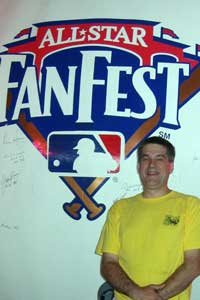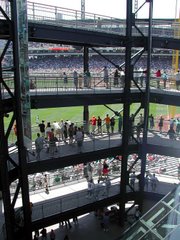I commented last week about the Pirates trading away Chris Young, who's become a star pitcher for the Padres, in exchange for Matt Herges, who didn't even make Pittsburgh's roster coming out of spring training.
Of course, hindsight ... well, you know how that goes. There have been plenty of trades throughout baseball history involving young players no one has heard of who later turn out to be stars, or old-timers who suddenly get a second wind with a new team. Before the advent of free agency, at least, trades were lopsided only in retrospect. Here are some more that didn't turn out so well for one of the parties involved:
• Dec. 15, 1900: Cincinnati Reds trade Christy Mathewson to New York Giants for Amos Rusie. The granddaddy of all one-sided trades involved two future Hall of Famers. The problem was that Mathewson had 372 wins ahead of him for the Giants, while Rusie failed to win a game for the Reds. Mathewson actually had pitched a few games for New York in 1900, but Cincinnati drafted him after he was sent back to the minors. Eager to reacquire Mathewson, the Giants offered Rusie, the dominant pitcher of the 1890s. Unfortunately, he'd sat out the previous two seasons in a contract dispute, and the layoff showed in 1901: In three games, Rusie posted an 0-1 record and 8.59 earned run average. Mathewson won 20 games as a rookie and became, posthumously, a charter member of baseball's Hall of Fame.
• Aug. 31, 1990: Boston Red Sox trade Jeff Bagwell to Houston Astros for Larry Andersen. Bagwell was a fairly good prospect in the Sox' organization, but Boston was looking to bolster its bullpen for the stretch drive. Although he was 37, Andersen was one of the best middle relievers in the game at the time, and pitched well during his month with the Sox, giving up only three runs in 15 appearances, before signing a lucrative free-agent contract with San Diego, retiring after two years there. Bagwell had some success in Houston, of course, setting a franchise record with 449 home runs during his 15-year career.
• Dec. 4, 1968: Houston Astros trade Mike Cuellar, Enzo Hernandez and Elijah Johnson to Baltimore Orioles for Curt Blefary and John Mason. This may have looked like a decent trade at the time. The Orioles had seen a number of talented young pitchers - among them Chuck Estrada, Wally Bunker and Steve Barber - go by the wayside with various arm injuries, and the team was unsure about Jim Palmer, who was nursing an ailment at the time. Houston, playing in the offense-challenged Astrodome, was looking for a bat to add to the lineup. Blefary, the American League Rookie of the Year in 1965, seemed to fit the bill, although he'd hit .200 in 1968. (In his defense, the AL as a whole hit .230 in the Year of the Pitcher.) Cuellar was a 31-year-old who'd gone 8-11 in '68, but the Orioles felt his veteran presence could help the staff. The O's went on the win 109 games in '69, with Cuellar tying with Denny McLain for the Cy Young Award, and Cuellar won at least 18 games each year through '74. Blefary, age 25, hit .253 with 12 home runs and 67 runs batted in during his only season in Houston.
• Nov. 29, 1971: San Francisco Giants trade Gaylord Perry and Frank Duffy to Cleveland Indians for Sam McDowell. At the time of the trade, "Sudden" Sam was averaging more than a strikeout per inning, a rarity in those days. After finishing third in the AL Cy Young balloting in 1970, McDowell went 13-17 the following season with an awful Indians team. Perry had won more than 20 games twice for the Giants, but was overshadowed on the staff by Juan Marichal. The change of pace was great for Gaylord, who won 24 games and the Cy Young in '72, joining Jim Perry as the only brothers to earn the award. McDowell, a Pittsburgh native who'd just turned 30, won only 19 games the rest of his career.
• April 5, 1975: Philadelphia Phillies trade Bill Robinson to the Pittsburgh Pirates for Wayne Simpson. Robinson, who'd been a bust for the post-dynasty Yankees of the late '60s, became a fan favorite after cracking 25 home runs for the '73 Phillies, not quite as common an occurrence in those days. He'd slumped considerably in 1974, and the Phillies, looking for pitching help, decided to take a chance on Simpson although he never pitched an inning for the Pirates. Phils general manager Paul Owens no doubt was remembering Simpson's work as a rookie in Cincinnati, where he went 14-3 before hurting his arm in 1970. His health problems persisted in Philadelphia, where he went 1-0 in seven games in '75. Robinson got off to a slow start in Pittsburgh, but batted in 104 runs in '77 and was an integral part of the '79 championship team.
• March 27, 1987: Philadelphia Phillies trade Gary Redus to Chicago White Sox for Joe Cowley. Redus was a serviceable player with some power and speed who ended up bouncing around the majors for 13 years, never really finding a full-time role. The Phillies thought they were getting some pitching help, as Cowley had shown flashes of brilliance: He'd pitched a no-hitter for the White Sox and set an AL record in another game by striking out the first seven batters he faced. Once he arrived in Philly, though, Cowley was just plain awful. In four starts during April, he gave up a total of 23 runs while starting 0-4. On May 3, Phillies manager John Felske called Cowley in to relieve Kevin Gross. In the fourth inning, Cowley got Ron Oester out before giving up a single to opposing pitcher Bill Gullickson, then walking Kal Daniels and Kurt Stilwell to load the bases. Cowley left the mound, his last appearance in the majors, and watched all the runners he put on base score when Eric Davis hit a grand slam. He left with a 15.43 ERA for the season.
• Dec. 9, 1982: New York Yankees trade Fred McGriff, Dave Collins, Mike Morgan (and cash) to Toronto Blue Jays for Dale Murray and Tom Dodd. Having missed the playoffs in '82 for only the second time in six years, the Yankees traded for Murray, a 32-year-old righthander who'd been the star of Toronto's bullpen, for what that was worth, in '82. Collins had distinguished himself by stealing 79 bases for the Reds in 1980, but had swiped only 13 while hitting .253 in his only season with the Yankees. Morgan was a phenom who debuted with Oakland at age 18 in '78, but was in the early stages of what would become his epic 12-team, quarter-century odyssey through the majors. As for McGriff ... he'd just turned 19 and was merely another outfielder in the Yankees' system. With the Blue Jays and later the Padres, McGriff became the first player since the Dead Ball Era to lead both leagues in home runs, on his way to barely missing 500 for his career.
• May 8, 1966: San Francisco Giants trade Orlando Cepeda to St. Louis Cardinals for Ray Sadecki. Cepeda was a monster his first seven seasons with the Giants, averaging better than .300 and 30 home runs, but suffered a major injury in 1965. San Francisco had been trying to work Cepeda and Willie McCovey, both first baseman, simultaneously into the lineup for years, and McCovey had stepped in nicely in '65, belting 39 home runs. His performance apparently made Cepeda expendable, and with Bill White having departed St. Louis, the Cardinals were looking for a quality first baseman. They offered Sadecki, a lefthander who'd won 20 games in the Cards' Series-winning season of '64 but slumped to 6-15 the following season. Sadecki was just 25 at the time of the trade, but never won more than a dozen games in a season again. Cepeda hit .303 the rest of the way for St. Louis in '66, then led the league in RBI the following year on his way to becoming the first unanimous choice for Most Valuable Player in National League history.
Trivia question 35: For which current major-league manager was Orlando Cepeda traded following the 1968 season?
Subscribe to:
Post Comments (Atom)









No comments:
Post a Comment